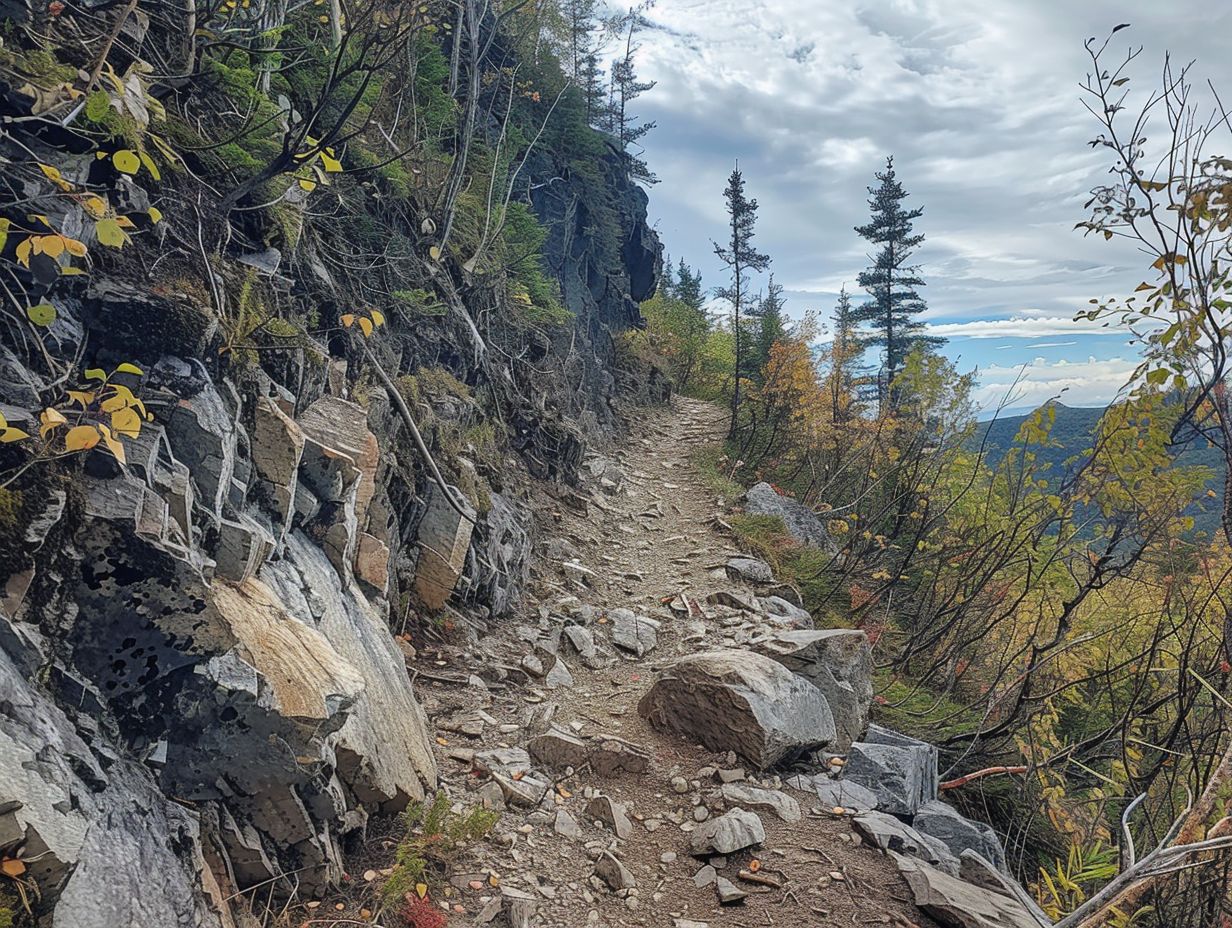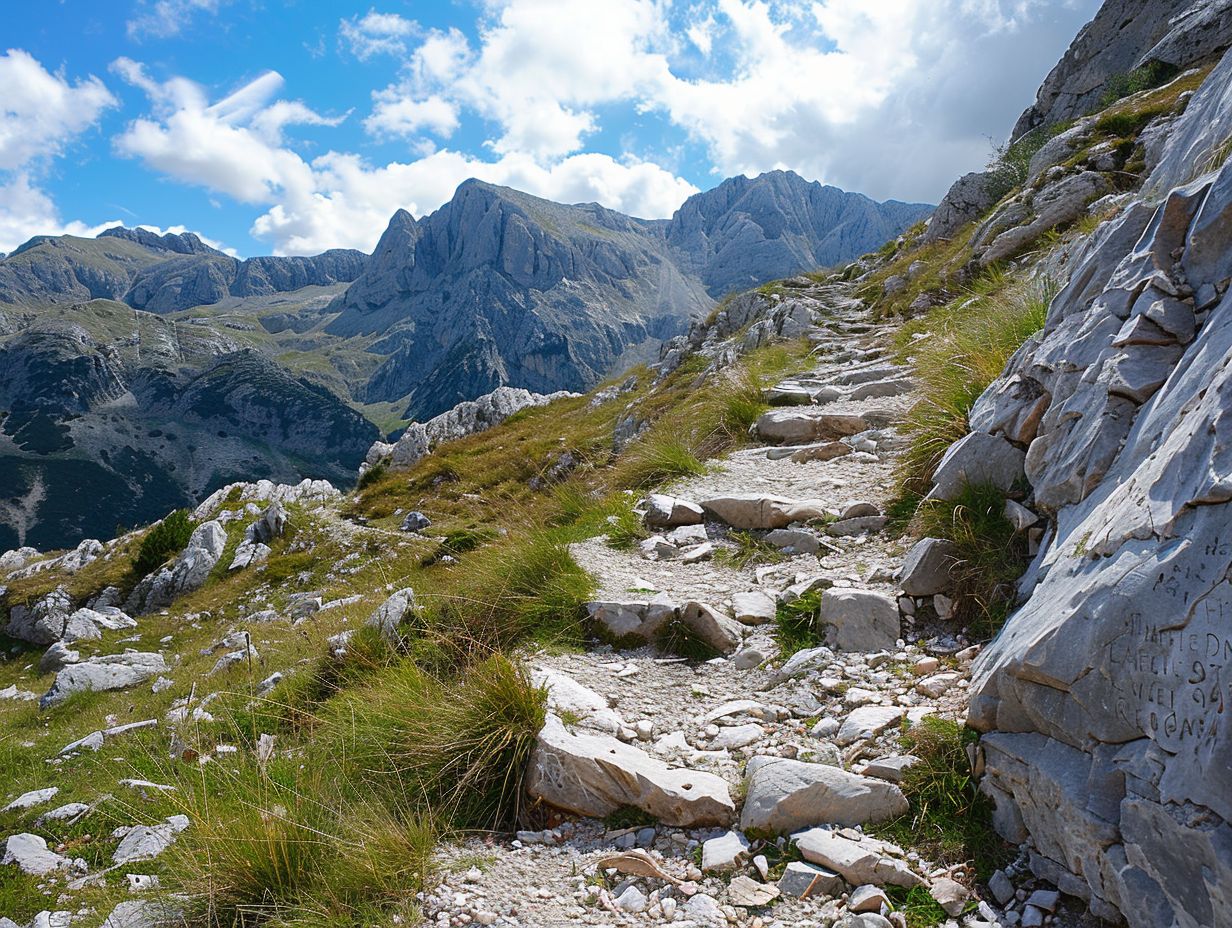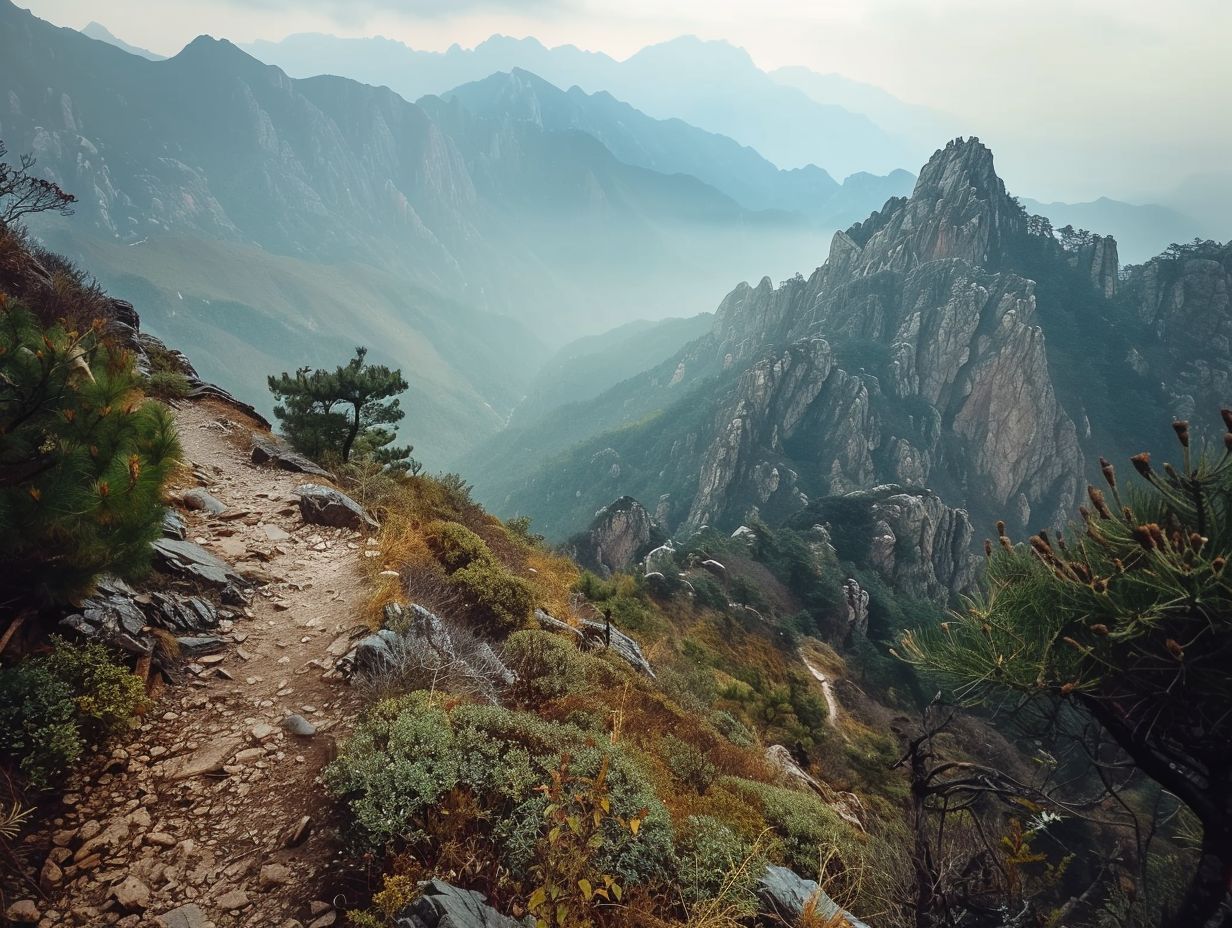
Kilimanjaro Trail Conditions
Are you ready to conquer the Kilimanjaro Trail?
We explore the different routes to the summit, factors that can affect trail conditions like weather, altitude, and terrain, and current trail conditions.
Learn what to expect on the trail, including challenges and obstacles you may face. Get tips on preparing for the Kilimanjaro Trail, from physical fitness and training to proper gear and equipment.
Embark on this epic adventure now!
Key Takeaways:

- Proper preparation is key for a successful Kilimanjaro trek. Train physically, pack appropriate gear, and mentally prepare for the challenges ahead.
- Weather, altitude, and terrain are the key factors that affect trail conditions. Stay updated with current conditions and be ready to adapt to changes.
- The Kilimanjaro Trail offers a variety of routes with varying levels of difficulty. Research and choose the best route for your fitness level and experience.
What is the Kilimanjaro Trail?
The Kilimanjaro Trail refers to the journey to summit Mount Kilimanjaro, the highest peak in Africa, renowned for its breathtaking views, diverse ecosystems, and challenging terrains. Hiking through the Kilimanjaro Trail offers an unforgettable experience of exploring various landscapes and encountering unique wildlife and plant species.
One of the remarkable aspects of the Kilimanjaro Trail is its five distinct ecological zones, each characterized by its own vegetation and climate. From the lush rainforest zone at lower altitudes to the alpine desert and arctic summit climate zones, hikers witness a dramatic change in scenery and conditions. The trail also provides a glimpse into the local culture as it passes through villages and offers interactions with the friendly local guides and porters.
Reaching the Uhuru Peak, the summit of Mount Kilimanjaro, is a feat that rewards adventurers with a sense of accomplishment and a panoramic view that stretches across the African plains.
-
What are the Different Routes to the Summit?
Mount Kilimanjaro offers several routes to reach the summit, including the Lemosho, Marangu, Machame, Rongai, and Umbwe routes. Each route offers unique challenges and experiences, culminating at Uhuru Peak, the highest point on Kilimanjaro and a symbol of triumph and endurance.
Among these routes, the Lemosho route stands out for its scenic beauty, traversing diverse landscapes from lush forests to alpine deserts. It is renowned for offering climbers a gradual ascent, allowing for better acclimatization and increased chances of reaching the summit successfully. In contrast, the Marangu route, also known as the ‘Coca-Cola route,’ features more gradual slopes but is popular for its hut accommodations along the way.
-
How Long Does it Take to Complete the Kilimanjaro Trail?
The duration to complete the Kilimanjaro Trail varies depending on the chosen route and individual climbing skills. On average, it takes about 5 to 9 days to ascend and descend the mountain, with additional time for acclimatization and adjusting to altitude changes.
Factors such as the selected route play a crucial role in determining the length of the expedition. Routes like the Marangu Route, known for its relative ease, might take around 5 to 6 days to complete, while more challenging paths like the Machame Route can extend the journey to 6 to 9 days.
Summiting the Uhuru Peak, the highest point on Kilimanjaro, often involves tackling steep terrain, icy sections, and unpredictable weather conditions, adding complexity to the climb and potentially extending the duration. Developing excellent climbing techniques and physical conditioning are paramount for a successful and timely ascent.
What are the Factors that Affect Trail Conditions?
Various factors influence the trail conditions on Kilimanjaro, including weather patterns, altitude variations, terrain characteristics, and the risk of altitude sickness. These factors play a crucial role in determining the overall difficulty and safety of the climbing expedition.
Weather patterns on Kilimanjaro can change rapidly, impacting temperatures and visibility. The mountain’s altitude ranges lead to temperature fluctuations, affecting hikers’ comfort and gear requirements.
The diverse terrain types, from rocky paths to snowy slopes, pose unique challenges. Altitude-related challenges, such as decreased oxygen levels, can result in health issues like altitude sickness, affecting climbers’ performance and safety. It is vital for climbers to be well-prepared and adapt to these changing conditions to ensure a successful ascent.
-
Weather and Climate:
The weather and climate on Mount Kilimanjaro can vary significantly, ranging from tropical conditions at the base to freezing temperatures at the summit. Understanding the weather patterns is crucial for a successful trek and summiting experience.
- At the lower altitudes, hikers may encounter warm, humid weather typical of a tropical environment, with lush vegetation and occasional rain showers providing a refreshing atmosphere.
- As climbers ascend higher, temperature drops steadily, and the landscape transforms into an alpine desert, characterized by rocky terrain and sparse vegetation.
- Acclimatization becomes paramount due to the increasing altitude and thinner air, necessitating a gradual pace to mitigate altitude sickness risks for a safe and enjoyable journey.
-
Altitude and Elevation:

Altitude and elevation play a significant role in the Kilimanjaro trail conditions, particularly as climbers ascend to higher altitudes where oxygen levels decrease. Acclimatization is essential to mitigate the risks of altitude sickness and ensure a safe climbing journey.
When ascending Kilimanjaro, climbers must be mindful of the challenges posed by high altitudes. Altitude sickness, also known as acute mountain sickness, can affect individuals at altitudes above 8,000 feet, causing symptoms such as headaches, nausea, and fatigue. Proper acclimatization involves allowing the body time to adjust to the decreasing oxygen levels by ascending gradually, staying hydrated, and maintaining a steady pace.
One common strategy to aid acclimatization is the ‘climb high, sleep low’ approach. Climbers ascend to higher altitudes during the day to improve their physiological adaptation to lower oxygen levels and then descend to lower elevations to sleep, allowing their bodies to recover and rest.
-
Terrain and Difficulty:
The diverse terrains on Kilimanjaro present varying levels of difficulty, from lush rainforests to arctic zones. Climbers need to navigate through rocky paths, steep inclines, and icy slopes, requiring proper gear such as ice axes and crampons for a safe climbing experience.
Traversing the rainforest zone at the base of the mountain involves navigating through dense vegetation and occasionally slippery paths due to the moisture. As climbers ascend, the landscape transitions into moorland characterized by expansive grasslands and volcanic rock formations.
The challenging alpine desert zone poses obstacles like loose scree and high altitudes that demand acclimatization for overcoming altitude sickness. The summit trek through the stark arctic zone tests endurance with freezing temperatures and low oxygen levels.
What are the Current Trail Conditions?
Assessing the current trail conditions on Kilimanjaro involves monitoring recent weather patterns, trail maintenance efforts, and rescue operations to ensure the safety and accessibility of the climbing routes. Keeping track of these conditions is essential for planning a successful climbing expedition.
Weather patterns play a crucial role in the safety of climbers on Kilimanjaro, as sudden changes can create hazardous conditions. Regular trail maintenance not only ensures the physical accessibility of the routes but also helps preserve the natural environment. The availability of well-organized rescue operations acts as a vital safety net in case of emergencies. By combining these elements, climbers can expect a smoother journey up the majestic peak of Kilimanjaro.
-
Recent Weather Patterns:
Tracking recent weather patterns on Kilimanjaro is crucial for climbers to prepare adequately for the journey, as sudden changes can impact trail conditions and safety. Understanding the climate trends helps in optimizing the trekking experience and minimizing weather-related risks.
Being aware of the weather conditions allows climbers to adjust their equipment and clothing accordingly, ensuring they are well-prepared for any unexpected changes in temperature or precipitation.
Real-time monitoring helps in making informed decisions about when to start the climb, select the best route, and anticipate possible challenges along the way. Having access to up-to-date weather data assists in enhancing overall safety measures and emergency preparedness, reducing the likelihood of weather-related accidents or setbacks.
-
Trail Maintenance and Upkeep:
Effective trail maintenance and upkeep are essential for preserving the integrity of the Kilimanjaro routes, ensuring a smooth and safe hiking experience for climbers. Proper maintenance practices contribute to the sustainability of the trails and the preservation of the mountain ecosystem.
The well-maintained trails not only enhance the safety of the climbers but also protect the fragile habitats and unique flora and fauna that exist along the slopes of Kilimanjaro.
By minimizing erosion and preventing trail degradation, maintenance efforts help in conserving the natural beauty of the landscape. For hikers, well-maintained trails offer clear pathways, reducing the risk of getting lost and ensuring a more enjoyable adventure. Maintaining these trails elevates the overall climbing experience by providing a sense of structure and guidance.
What to Expect on the Kilimanjaro Trail?
Embarking on the Kilimanjaro Trail offers a mix of diverse trail conditions, ranging from lush rainforests to barren alpine deserts, each presenting unique challenges and obstacles. The journey includes encounters with fascinating wildlife and breathtaking landscapes, making the experience truly unforgettable.
Climbers can expect to navigate through different ecological zones, starting with the vibrant rainforest where the air is thick with humidity and the canopy teems with chirping birds and cheeky monkeys. As they ascend, the terrain transitions into heath and moorland, characterized by rolling hills and otherworldly plant species like the giant groundsels and lobelias unique to the region.
Continuing upward, trekkers will find themselves in the alpine desert, a stark and rugged landscape dominated by volcanic rocks and sparse vegetation. At this altitude, the thin air poses a significant challenge, testing climbers’ endurance and acclimatization.
The final stretch to the summit involves traversing steep scree slopes and potentially encountering freezing temperatures and high winds. Yet, the sight of the glacier-capped peak and the sunrise from Uhuru Peak are rewards beyond compare, marking the pinnacle of the Kilimanjaro Trail experience.
-
Typical Trail Conditions:

The Kilimanjaro Trail presents a mix of typical trail conditions, including steep ascents, rocky paths, and challenging terrains that test climbers’ physical fitness and endurance. Hikers must navigate through various landscapes, adapting to the changing conditions to reach their summit goals.
As climbers ascend Kilimanjaro, they encounter a range of ecosystems, from lush rainforests to alpine deserts, each demanding different exertions on the body. The altitude also plays a significant role, with the decreasing oxygen levels requiring climbers to acclimatize properly to avoid altitude sickness.
Physical fitness is crucial for climbers to tackle the demanding slopes and long trekking days. Endurance, strength, and cardiovascular fitness are key components in successfully conquering this majestic mountain.
-
Challenges and Obstacles:
Overcoming challenges and obstacles is an integral part of the Kilimanjaro climbing experience, as climbers face altitude-related difficulties, extreme weather conditions, and physical exertion during the ascent. Dealing with obstacles requires mental strength, proper preparation, and adherence to safety guidelines.
Climbers on the Kilimanjaro Trail often encounter the daunting challenge of altitude sickness, which can manifest in symptoms like headache, nausea, and fatigue due to the rapid altitude gain.
The unpredictable weather on the mountain poses another significant hurdle, with sudden temperature drops, high winds, and intense sunlight adding to the climbers’ difficulties.
Aside from physical challenges, climbers must maintain a strong mental fortitude to push through moments of doubt, exhaustion, and mental fatigue to reach the summit.
How to Prepare for the Kilimanjaro Trail?
Preparing for the Kilimanjaro Trail involves focusing on physical fitness through training regimens, acquiring the appropriate gear and equipment for the climb, and developing mental preparedness to tackle the challenges of ascending the mountain. Adequate preparation is key to a successful and enjoyable climbing experience.
Regular cardiovascular and strength training routines should be a core part of your preparation. Training hikes on steep terrains with a loaded backpack can simulate the conditions you’ll face on the trail. Investing in high-quality hiking boots, moisture-wicking clothing, layers to adjust to changing temperatures, and a durable backpack is critical.
Mental resilience is equally important, as the altitude and rugged terrain can test your endurance and determination. Building mental fortitude through visualization techniques and positive affirmations can boost your confidence on the journey.
-
Physical Fitness and Training:
Achieving optimal physical fitness is crucial for tackling the challenges of the Kilimanjaro Trail, requiring climbers to engage in specialized training programs that focus on endurance, strength, and cardiovascular fitness. Seeking guidance from experienced trekking guides can help in developing tailored training routines for the climb.
Physical fitness plays a pivotal role in determining the success of climbers embarking on the Kilimanjaro expedition. Engaging in a variety of exercises such as hiking, running, and strength training is essential to build the necessary stamina and muscle strength required for the demanding trek.
Endurance-building techniques like interval training and uphill walking can be particularly beneficial in preparing climbers for the sustained physical exertion at high altitudes.
Professional guides not only provide invaluable insights into the terrain and potential challenges of the trail but also offer expert advice on nutrition, acclimatization strategies, and mental preparation, ensuring climbers are well-equipped for the arduous journey ahead.
-
Proper Gear and Equipment:
Selecting the proper gear and equipment is paramount for a successful Kilimanjaro climbing experience, as climbers need to be equipped with essentials such as ice axes, crampons, and appropriate clothing for varying weather conditions. Having the right gear enhances safety, comfort, and overall performance during the ascent.
Alongside ice axes and crampons, essential climbing tools include harnesses, helmets, and sturdy ropes to help navigate the challenging terrain. Specialized equipment such as high-altitude mountaineering boots offer crucial traction and insulation against freezing temperatures. Protective clothing like moisture-wicking base layers, insulated jackets, and waterproof outer shells are vital to combat harsh weather.
For those without their own gear, many reputable outfitters offer gear rental services ranging from tents to sleeping bags, making the climb more accessible to all aspiring adventurers.
-
Mental Preparation and Mindset:
Developing mental preparation and a resilient mindset is key for conquering the challenges of the Kilimanjaro Trail, as climbers navigate through physical exertion, altitude variations, and unpredictable weather conditions. Cultivating a positive outlook, mental strength, and effective coping strategies are essential for a successful climbing journey.
Amidst the towering peaks and rugged terrain of Mount Kilimanjaro, climbers are faced with not just a physical test of endurance but also a mental battle that tests their determination and resilience.
Managing stress and anxiety becomes crucial amidst the unfamiliar environment where mental fortitude can be the difference between success and setback. Prioritizing mental well-being while honing climbing skills enables climbers to stay focused on the task at hand, remaining adaptable to the changing landscapes and conditions that come their way.
Frequently Asked Questions:
1. What are the current trail conditions on Kilimanjaro?
A: The current trail conditions on Kilimanjaro vary depending on the time of year and weather conditions. It is important to check with a local guide before beginning your journey to ensure that you are prepared for the specific conditions you may encounter.
2. Are there any potential hazards on the Kilimanjaro trail?
A: Yes, there are several hazards that hikers may encounter on the Kilimanjaro trail. These can include extreme weather conditions, steep and rocky terrain, and high altitude sickness. It is important to be prepared and have a knowledgeable guide to assist you on the trail.
3. Is it safe to hike the Kilimanjaro trail alone?
A: No, it is not recommended to hike the Kilimanjaro trail alone. It is important to have a guide or join a guided tour group to ensure your safety and success on the trail. Guides are familiar with the trail conditions and can assist in case of any emergencies.
4. What is the best time of year to hike the Kilimanjaro trail?
A: The best time of year to hike the Kilimanjaro trail is during the dry season, which typically runs from June to October. This is when the weather is most stable and the trails are less slippery. However, it is possible to hike during the wet season as well, as long as you are prepared for potential rain and mud on the trails.
5. Are there any restrictions or permits required to hike the Kilimanjaro trail?
A: Yes, there are certain permits and fees required to hike the Kilimanjaro trail. These include a national park entrance fee, camping fees, and a climbing permit. It is important to obtain these permits in advance and have them with you during your hike.
6. What should I pack for my Kilimanjaro trail hike?
A: It is important to pack proper gear and supplies for your hike on the Kilimanjaro trail. This includes warm and waterproof clothing, sturdy hiking boots, a sleeping bag, and enough food and water for the duration of your hike. It is also recommended to bring any necessary medications and a first aid kit.